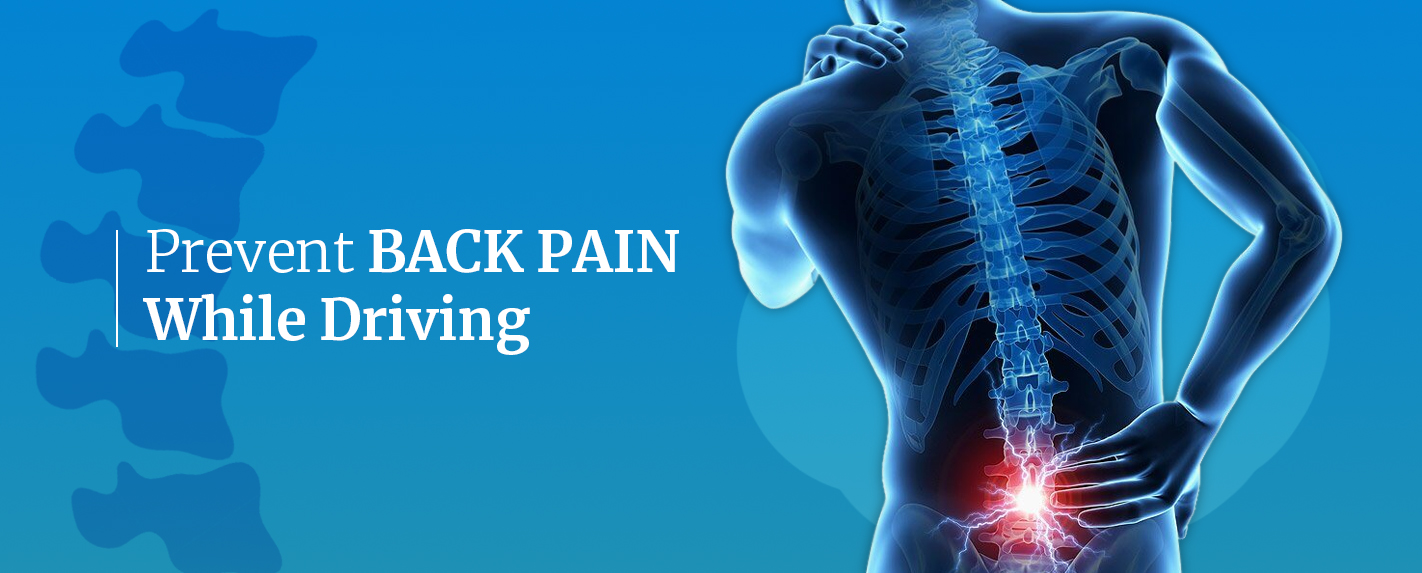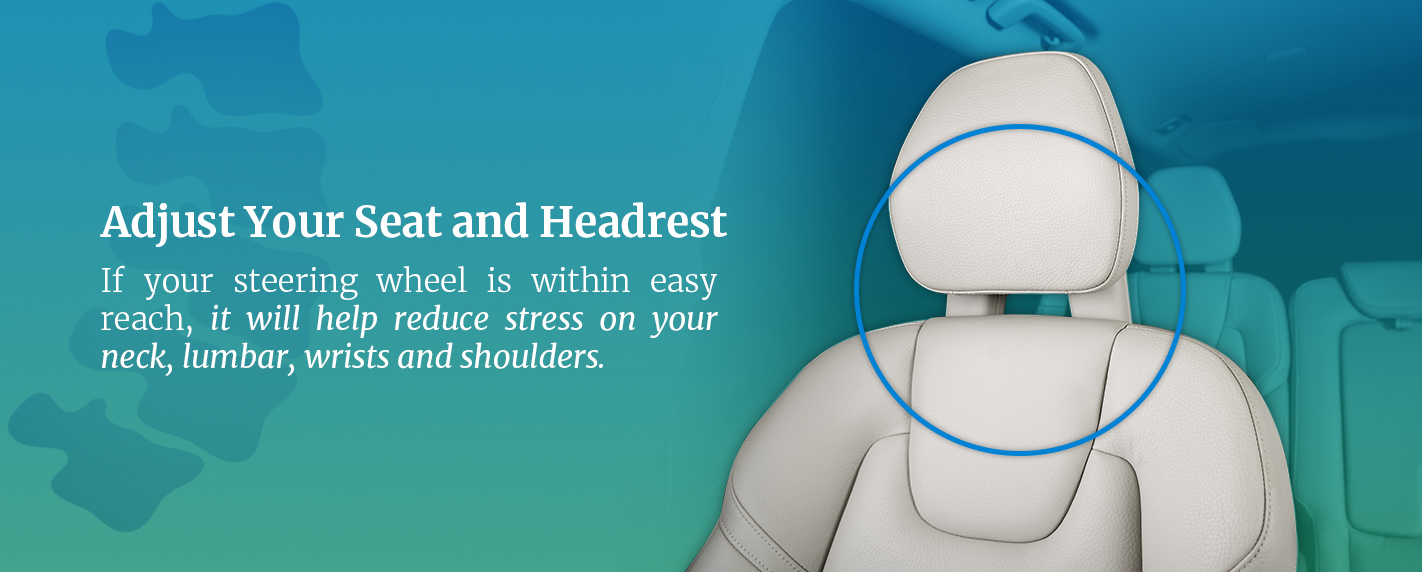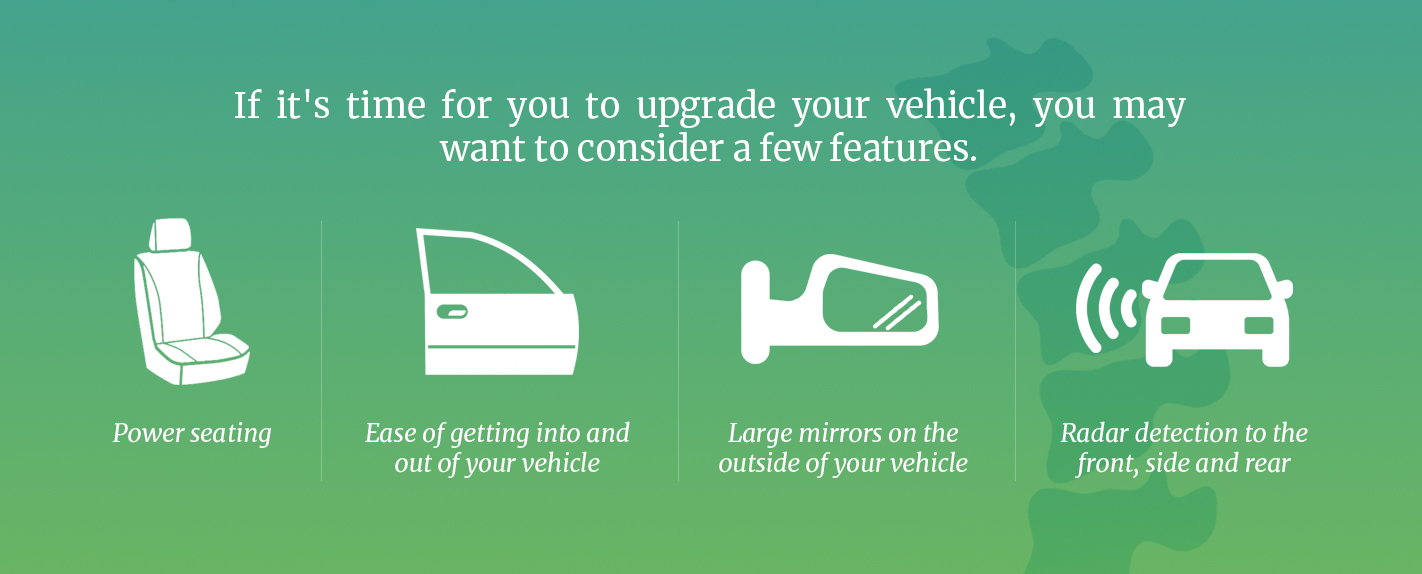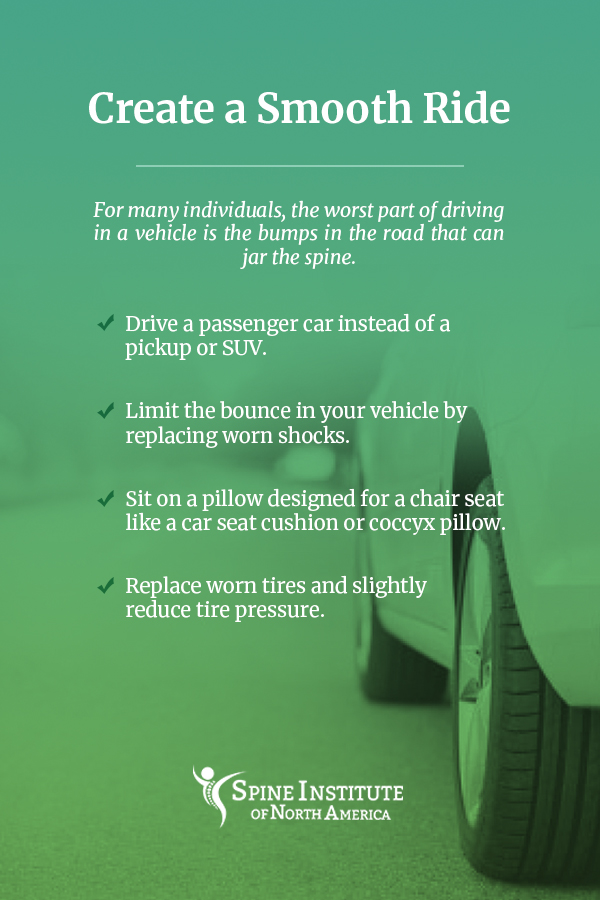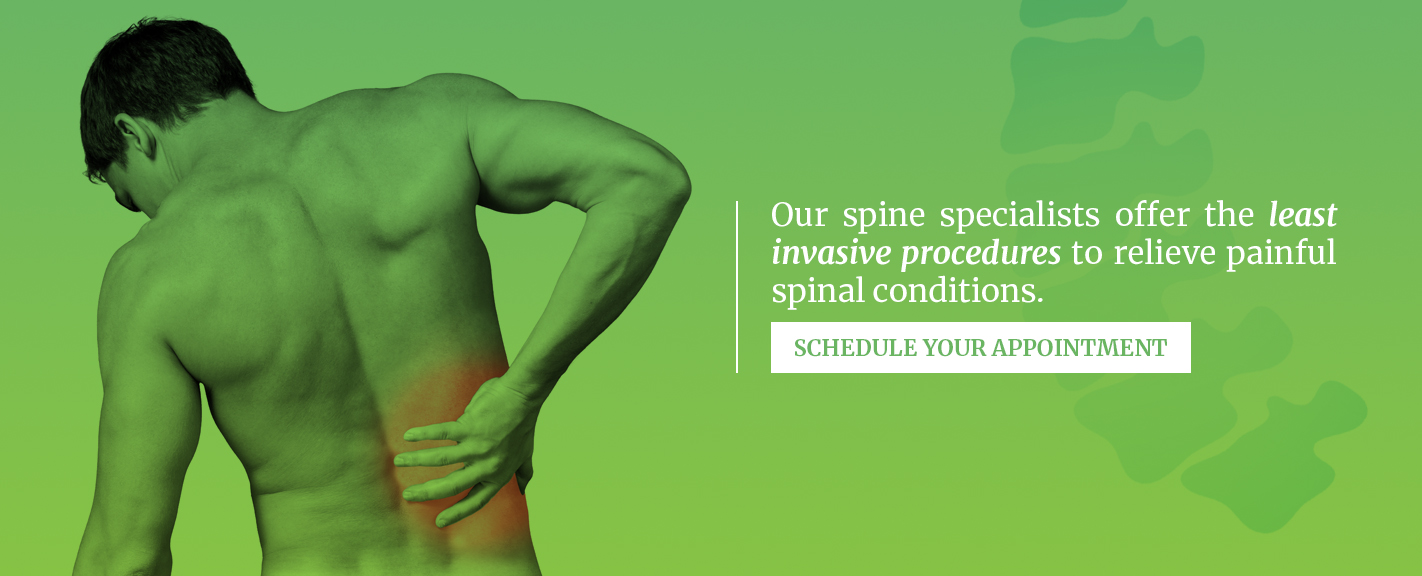Prolonged sitting, whole body, low-frequency vibrations and constrained postures while driving can lead to back pain. It’s no fun for anyone to drive with lower, middle or upper back pain. Whether you’re driving to work every day or taking a trip that requires being behind the wheel for an extended period of time, you shouldn’t have to suffer the whole time you’re in your vehicle.
If back pain while driving becomes frequent and makes it difficult for you to drive, you might worry you won’t be able to drive anymore. Don’t give up the thrill of the road just yet. With some modifications and a little effort on your part, you should be able to prevent back pain while driving.
Below, you’ll find some ergonomic tips to reduce or eliminate back pain so you can drive more comfortably. But first, let’s go over some of the causes.
Call today
Causes of Back Pain While Driving
When you’re sitting in your vehicle, and it’s not moving, it’s likely the same as sitting in a cushioned chair. But the minute your car begins moving, everything is different. Unlike regular sitting, while your vehicle is in motion and subject to accelerations and decelerations, your body experiences various forces, including whole-body up-and-down vibrations, as it sways from side to side.
Investigators have researched how whole-body vibration affects an individual sitting in the seat of a car. Your lumbar spine has a natural resonant frequency of four to five Hz, and the research results show laboratory-simulated vehicle driving excited this natural frequency, leading to high lower back spinal loadings. And, this can lead to more considerable postural discomfort as well as an increased risk of lower back injury and pain.
In May 2015, a study published in the International Archives of Occupational and Environmental Health showed individuals who often experience whole-body vibrations, like those who drive for a living, have twice the risk of experiencing sciatica and lower back pain than individuals who don’t.
When you drive, you’re also actively using your feet — your right foot on the accelerator pedal and your left foot on the brake or on the clutch with a manual-transmission vehicle. When your feet are active, they can’t help stabilize and support your lower body like they would typically do when you place them on the floor while sitting in a chair. These combined factors, along with the design of the vehicle’s seat itself, can increase your risk of experiencing back issues.
Here are some of the more common causes of back pain. While these causes are specific to driving, other factors such as posture, overuse, or underlying conditions can also contribute.
1. Poor Posture
Good posture is essential. If you routinely sit with poor posture for long periods or live a sedentary lifestyle, it can lead to structural changes in your neck and back. Your muscles could become weak and deconditioned and therefore not hold your spine in neutral alignment as well as it did before. When you hunch your shoulders and head forward, it places more pressure on your spine’s:
- Bones
- Muscles
- Discs
- Soft tissues
- Ligaments
If you tend to lean to one side frequently, like while working at a computer or driving, it could also lead to an upper back imbalance that causes pain. Also, if you sit on your wallet, your pelvis, hips and back can be uneven, leading to back pain.
2. Overuse
Overusing your ligaments and muscles outside of driving can cause back pain that can carry on while you drive. When you overtax areas of the lumbar spine, your soft tissues can become strained and inflamed, potentially leading to muscle spasms and pain.
3. Accident or Collision
A fall from a height, trauma from a vehicular accident or a sports collision can lead to upper back pain by injuring spinal discs, bones, ligaments, muscles, soft tissues and nerves.
4. Improper Lifting Technique
If you lift a heavy object and do not keep your spine aligned, it can add stress on your upper back. Holding or lifting a heavy object above your head, particularly more toward the right or left instead of the center, can make your upper back and shoulder vulnerable to injury.
5. Compression Fractures
A vertebral bone can become weak and lose its ability to fully support the weight above it. Older adults with osteoporosis can experience this. Small fractures develop on the vertebra at the front as it becomes compressed, which causes the vertebra to form a wedge shape. If the vertebra loses height, it can lead to postural changes and cause pain.
6. Arthritis
Different forms of arthritis can develop or spread to your thoracic spine, from an autoimmune disease like rheumatoid arthritis or osteoarthritis resulting from natural wear and tear.
7. Thoracic Herniated Disc
While thoracic spine herniated discs aren’t uncommon, it’s rare for them to cause symptoms like pain. In general, natural spinal degeneration from aging is more likely to lead to lumbar or cervical spine symptoms.
As you age, your body doesn’t behave the way it used to. If you’re experiencing back pain, disc degeneration may be the cause. Learn about the five most common types of disc degeneration complications here
Posted by Metropolitan Pain & Spine Institute on Saturday, April 17, 2021
8. Severe Spinal Deformity
If you have a severe spinal deformity, it can lead to stress on your joints and discs and painful muscle spasms. A couple of examples are scoliosis and Scheuermann’s kyphosis.
9. Fibromyalgia
Fibromyalgia is a rare condition that can cause fatigue and widespread pain throughout your body. The upper back is one region where many people with fibromyalgia experience pain.
Several other causes of upper back pain include a tumor pressing on your spinal cord and an infection. All of these can make driving difficult.
Schedule a consult
Tips for Preventing Back Pain While Driving
1. Adjust Your Seat and Headrest
The first step you can take to alleviate back pain while driving is to adjust your seat correctly. You’ll want to sit fairly close to the steering wheel, but not so close it will compromise your safety. If your steering wheel is within easy reach, it will help reduce stress on your neck, lumbar, wrists and shoulders.
When you’re reasonably close, you won’t have to strain to reach the pedals. Make sure your knees aren’t higher than your hips. You should also adjust the angle of your seat so the back is at a 100- to a 110-degree angle, which will allow you to sit properly.
Your vehicle’s headrest should be in the middle of your head. Keep your neck and back of your head in a neutral position to ensure correct posture and positioning. Your shoulders should rest slightly behind your hips.
2. Create Lumbar Support
Be sure to center your back against the seat to maximize back support for your car. It might be necessary to add a lumbar support accessory, as many vehicles don’t have adequate lumbar support. Therefore, it can help to roll a sweatshirt up and place it behind the small of your back to provide back support for driving.
If you slightly bend your knees higher than your hips, it can take the pressure off your lower back and hamstrings. Your hips, back and neck work like cogwheels, so by turning one part, the other parts will move as well.
3. Change Your Steering Wheel Grip
Researchers have been looking into which way is best for you to position yourself at the steering wheel when you’re experiencing back pain. Before, experts suggested you hold your steering wheel at a 10 o’clock and 2 o’clock position. However, now with the prevalence of airbags, studies are finding you should place your hands at a 9 o’clock and 3 o’clock position for increased safety in the event of an airbag deployment. This position also allows you to rest your elbows on the vehicle’s armrests to help alleviate pain, particularly in your upper back.
4. Use Cruise Control
If your vehicle has cruise control, use it if you can safely. Cruise control will allow you to place both your feet on the floor for brief periods, distributing your weight more evenly.
5. Use Your Heated Seat Option If Your Vehicle Has It
Heat relaxes tight muscles and joints, decreases pain signal transmission to your brain and brings more blood, oxygen and nutrient flow to the area, thereby helping relieve pain. If you don’t have heated seats in your vehicle, you can purchase a heated seat cover and place it on your driver’s seat.
6. Take a Driving Break and Move Around
The spine enables your mobility. When you sit in one position in the vehicle, it will make your back muscles stiff, leading to potential muscle spasm and achiness. If you can, take a break from driving, preferably every 30 minutes. Safely pull over to the side of the road and get out of your vehicle so you can stretch and move around, which will stimulate blood circulation to your lower back.
Try and move a little in your seat in between these driving breaks. Even moving and stretching for 10 seconds is better than sitting still. At least adjust your seat and every 20 minutes, change your position. Stretch your hamstring muscles and keep the blood flowing by pumping your ankles. Any movement you can do in your vehicle safely will help.
7. Change the Way You Get in and out of Your Vehicle
Face away from the seat when getting in. Sit and swivel in. Don’t twist your back. Swivel out of the vehicle facing away from the seat. Use the frame of the door, if needed, to scoot forward. You can attach devices like a strap with a handle to the frame of the door for added support.
8. Buy a New Vehicle With the Right Features
If it’s time for you to upgrade your vehicle, you may want to consider a few features. These are:
- Power seating
- Ease of getting into and out of your vehicle
- Large mirrors on the outside of your vehicle
- Radar detection to the front, side and rear
9. Adjust Your Mirrors
Adjust your mirrors properly, so you don’t have to twist or move to see them. In general, you should only need to move your eyes to see out of the mirrors. Always adjust your mirrors while sitting up straight. That way, if you slouch, your mirrors will clue you to sit with good posture.
10. Bring a Cold or Heat Pack
Bring along a heat pack or cold pack with you, depending on the one that works best for your back pain. You can make a cold pack by wrapping an ice pack in a towel, or you can purchase an ice pack you can keep in your vehicle. You can plug some heat packs into your car’s 12-volt auxiliary socket to provide you with continuous heat. Or, use your heated seats if you have them.
If you’re still experiencing back pain while you drive, stop to stretch, then when you’re sitting, place the ice pack against your back. The ice pack numbs the area and reduces inflammation, which relieves back pain.
11. Create a Smooth Ride
For many individuals, the worst part of driving in a vehicle is the bumps in the road that can jar the spine. Here are some options, if this is the case for you:
- Drive a passenger car instead of a pickup or SUV
- Limit the bounce in your vehicle by replacing worn shocks
- Sit on a pillow designed for a chair seat like a car seat cushion or coccyx pillow
- Replace worn tires and slightly reduce tire pressure
12. Consider Back Pain Treatment From a Specialist
If you have arthritis that affects your driving, you should talk with your doctor about treatment options to ease pain, like non-narcotic medications.
You may also want to go to a physical or occupational therapist. With painful arthritis, being too active can worsen pain, but not moving around enough can do the same. A physical or occupational therapist will show you how to strike the perfect balance. They’ll work with you on stretching, exercising and strengthening. When you have good muscle tone, your joints can do their jobs better.
Schedule a consult
Contact Metropolitan Pain & Spine Institute for Your Back Pain
The Metropolitan Pain & Spine Institute knows how disruptive your back pain can be, and is here to help eliminate the pain. We understand how back pain can impact an individual’s daily routine and burden your life. We dedicate ourselves to getting to know you and understand your pain. We’re committed to restoring your quality of life.
Our spine specialists offer the least invasive procedures to relieve painful spinal conditions, so you can recover and be back to driving and living in comfort within a few days. It can be overwhelming trying to decide between interventional procedures, physicians or minimally invasive spinal surgery that might or might not even help with your pain.
We’ve had many satisfied patients walk into our office with excruciating pain, and now are back to driving and living pain-free. Contact Metropolitan Pain & Spine Institute today to schedule your appointment.
This content was medically reviewed by Baher Yanni, M.D, on May 22nd, 2019.
Sources:
https://www.researchgate.net/publication/232117966_Low_Back_Pain_and_Whole_Body_Vibration
https://www.ncbi.nlm.nih.gov/pubmed/25142739
https://www.everydayhealth.com/back-pain/back-pain-while-driving.aspx
https://www.spine-health.com/blog/7-tips-alleviate-back-pain-your-road-trips
https://www.spine-health.com/conditions/upper-back-pain/causes-upper-back-pain
https://www.simplebackpain.com/howtositinacar.html
https://www.telegraph.co.uk/cars/advice/avoid-back-pain-drivi
https://www.webmd.com/back-pain/get-through-the-day#1
https://health.clevelandclinic.org/5-tips-for-driving-when-you-have-arthritis-or-back-problems/
https://www.menshealth.com/health/a19539670/beat-back-pain-while-driving/
https://www.southeasternspine.com/driving-with-back-pain/
https://www.southeasternspine.com/10-driving-tips-to-save-your-back/
https://www.spineuniverse.com/wellness/ergonomics/driving-back-care
https://www.avogel.co.uk/health/muscles-joints/back-pain/back-pain-while-driving/
https://www.greenwichsportsmedicine.com/back-pain-while-driving/
https://www.thejournal.ie/driving-adjustments-for-back-pain-3846840-Feb2018/
